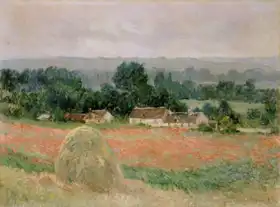About this finishing
Print. The image is printed on the top quality 10-ink HP Z9PS printer on HP matte 270 g / m2 paper. You can choose any size to an accuracy of 1 cm. A margin of 5 cm around the image is added to the size of the motif.


You can find a detailed description about our finishings
here.
Barns in Giverny
"The Haystacks at Giverny" (originally "Les Meules à Giverny") is a series of oil on canvas paintings painted by the famous French
impressionist painter
Claude Monet during his stay in Giverny in the 1890s. This series of paintings depicts haylofts, which were piles of straw or hay in rural fields, and is characterized by Monet's unique way of capturing light and atmosphere.
"The Haystacks at Giverny" is one of Monet's most famous and valuable series. Each painting in this series depicts haylofts in different lighting conditions and seasons. Monet carefully studied how light and shadow change over the course of the day and year, and his aim was to capture this variability.
The paintings "Haylands in Giverny" are characterized by strong colors and beautiful textures. Here, Monet uses different shades of pale gold and greenish color to create the impression of warm sunshine, but also shadows that depict the volume of the haystacks. These paintings are also a study of light and its effect on colors and atmosphere.
Impressionists such as Claude Monet were known for trying to capture the effects of light and atmosphere in a variety of settings and subjects. "The Haystacks of Giverny" is an important example of Monet's work in this direction and remains a symbol of his mastery of painting and his ability to capture the beauty of everyday scenes.
Prevailing color of this fine art print is green and its shape is landscape. This image is printed on demand - you can choose material, size and finishing.
Claude Oscar Monet (1840-1926). A native Parisian, who thoroughly developed the idea of
Impressionism. Monet almost scientifically studied the effect of light on different objects. He devoted himself to so called transitory states, which quickly led him to work with colour and light, his paintings acting on the viewer from the first impression. His use of open-air painting and objects which were special only because of light opened the way for the beginnings of modern painting. Monet’s
Impression, Sunrise (1874) not only gave the name to the whole art movement, but secured Monet a place among the best painters of all times. At one time, he resided in London and created his famous study
Houses of Parliament (Monet wondered, How could the English painters paint Parliament when it cannot be seen for the fog?). In the
Giverny, which became his favourite retreat after the death of his wife, he painted motifs from his garden and the popular series
Water Lilies - the world of the water was as poetic and mysterious as a primordial paradise.


